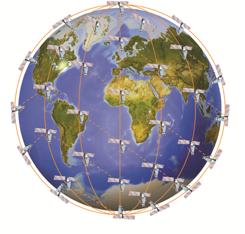Science Seen Physicist and Time One author Colin Gillespie helps you understand your world.
Iridium Skies Will Become Safer
Iridium Skies Will Be Safer
Losing an international flight over the ocean should soon become a thing of the past. This is a perk  that we will get from a new satellite array and a new airspace-safety business. The new satellites will do much more than that. Raymond Hall, a former trans-Pacific pilot, says they should generate ‘immense economic benefit.’ The Iridium upgrade is coming soon to skies near you.
that we will get from a new satellite array and a new airspace-safety business. The new satellites will do much more than that. Raymond Hall, a former trans-Pacific pilot, says they should generate ‘immense economic benefit.’ The Iridium upgrade is coming soon to skies near you.
Iridium is element 77 in the Periodic Table. It is also the name Motorola gave its constellation, Iridium SSC, of (as first planned) seventy-seven satellites. They provided world-wide phone service in the 1990s. Ground-based cell-phone competitors soon provided better, cheaper service for most users and the company went broke. Iridium Satellite LLC bought the whole show for a half cent on the dollar. Iridium Communications Inc., based in Virginia, now owns and operates it.
Last week a news story said that Iridium is planning to replace its existing constellation with new satellites. The plan is low-risk; it will use robust technologies and mature launch services. Iridium now uses 66 satellites. They are in six orbits, 476 miles above sea level. Each links to four others and to ground stations. They offer voice and data services to remote places. The new satellites will upgrade these services. They will also automatically track planes that carry the appropriate equipment.
The flight-tracking side of Iridium’s new business is a joint venture with Nav Canada and three European air-traffic-control (ATC) authorities, called Aerion LLC. Airspace safety is key to Aerion’s business. It works like this. Over land ATC tracks planes in flight and keeps them at least 1000 feet apart vertically and 5 miles horizontally. Most flight tracking today uses ground-based radar and radio signals. These technologies can reliably reach only 150 miles offshore. So an oceanic ATC system takes over before a flight gets out of range. ATC professionals describe these systems as ‘primitive’. For example, the Federal Aviation Administration’s Oakland Center controls flights over the North Pacific. It plots information that pilots transmit through third parties. This impairs the accuracy of flight monitoring, requiring greater distances between planes, which reduces the capacity of flight paths. Aerion’s system will allow oceanic spacings similar to those used over land. Pilots will be able to use more efficient routes. Fuel is the single biggest cost for airlines. More efficient routes and reduced delays waiting for airspace to be available will go straight to their bottom line so we can expect them to be eager to participate. And there is that fringe benefit: If a flight goes missing the authorities will know immediately and will have its altitude, precise track and last position.
For me and many colleagues the news about launching the new constellation is bittersweet. In the 1990s I was strategic counsel to Akjuit Aerospace Inc. Akjuit was building the world’s first commercial spaceport near Churchill on the shores of Hudson Bay. In the Cold War era, a U.S. Army sub-orbital-rocket range just out of town had more launches than any other range in the world and its records showed Churchill has fine rocket weather. Akjuit’s plan was to provide launch services for sending commercial satellites into low-Earth orbits—in those days a new and risky business. Someone said Akjuit was ‘a Company of Adventurers.’ It contracted with STC Complex of Moscow for surplus SS-25 inter-continental ballistic missiles to use as launch vehicles. Churchill’s location offered great trajectories for many planned commercial launches.
Iridium was the pace-setter for the small-sat field. Its initial failure took many other proposed constellations down. Investment bank Bear Sterns told us small satellites weren’t sexy anymore after the Iridium collapse. That spelled the end for Akjuit. Hopefully Iridium and Aerion will succeed this time and air travel will benefit. This is rocket science. Actually the science is mostly easy. But rocketry can still be a hard business.
Sources:
Eric Atkins (2015), “Iridium aims to save airlines money with new traffic-tracking satellites’, Toronto: The Globe and Mail, Aug. 30, http://www.theglobeandmail.com/report-on-business/iridiums-new-satellites-aim-to-save-airlines-money-by-tracking-traffic/article26158729/
National Air Traffic Controllers Association (1998), “Oceanic Modernization”, World Air Ops, vol. 3, p. 1; http://www.worldairops.com/FANS/docs/FANS_OceanicModernization_FAA_atWorldAirOps.com.pdf
Image source: European Space Agency, http://www.esa.int/var/esa/storage/images/esa_multimedia/images/2012/11/iridium_next_constellation/12111708-3-eng-GB/Iridium_NEXT_constellation.jpg

No comments yet.